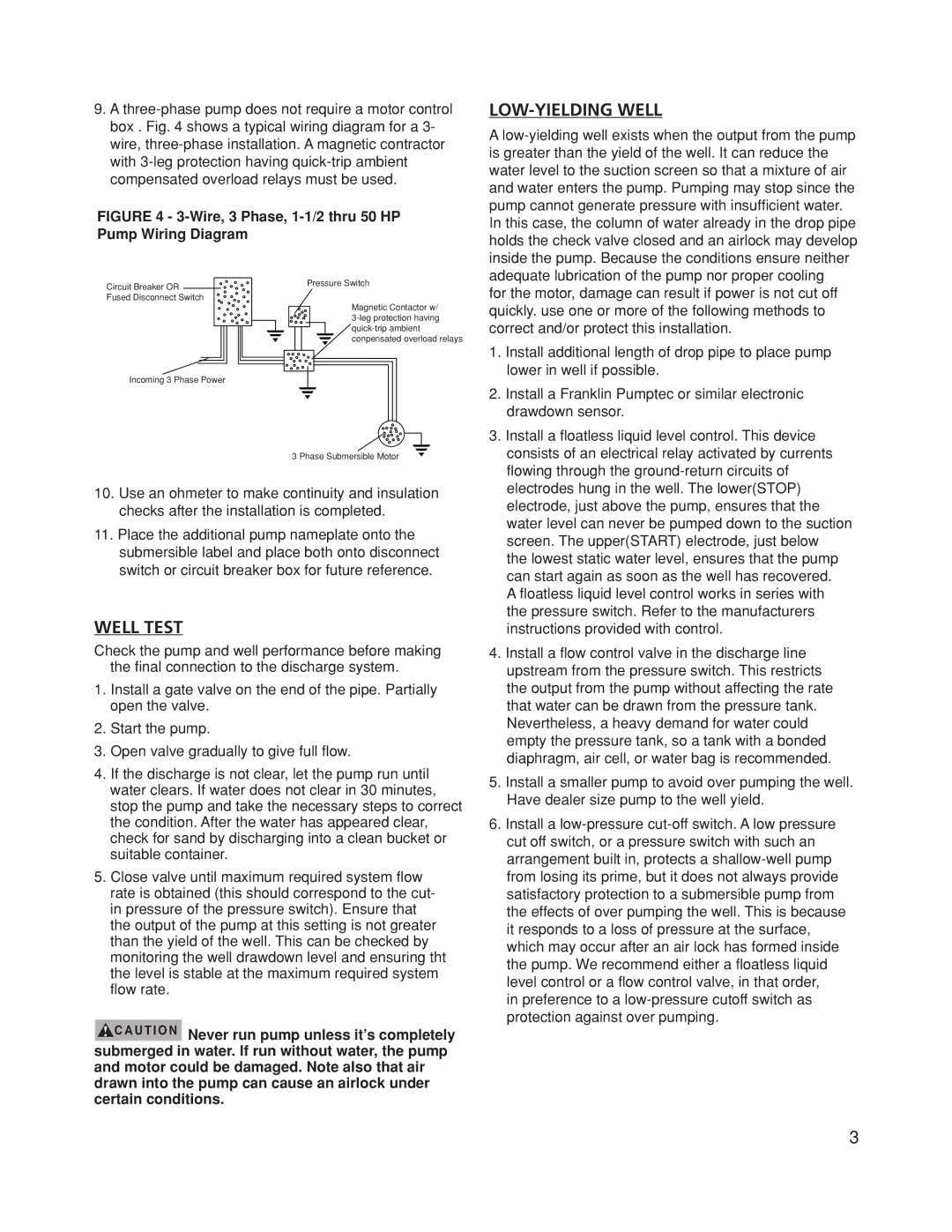
9.A
FIGURE 4 - 3-Wire, 3 Phase, 1-1/2 thru 50 HP Pump Wiring Diagram
LOW-YIELDING WELL
A
Circuit Breaker OR Fused Disconnect Switch
Incoming 3 Phase Power
Pressure Switch
Magnetic Contactor w/
3 Phase Submersible Motor
for the motor, damage can result if power is not cut off quickly. use one or more of the following methods to correct and/or protect this installation.
1. | Install additional length of drop pipe to place pump |
| lower in well if possible. |
2. | Install a Franklin Pumptec or similar electronic |
| drawdown sensor. |
3. | Install a floatless liquid level control. This device |
| consists of an electrical relay activated by currents |
| flowing through the |
10.Use an ohmeter to make continuity and insulation checks after the installation is completed.
11.Place the additional pump nameplate onto the submersible label and place both onto disconnect switch or circuit breaker box for future reference.
WELL TEST
Check the pump and well performance before making the final connection to the discharge system.
1.Install a gate valve on the end of the pipe. Partially open the valve.
2.Start the pump.
3.Open valve gradually to give full flow.
4.If the discharge is not clear, let the pump run until water clears. If water does not clear in 30 minutes, stop the pump and take the necessary steps to correct the condition. After the water has appeared clear, check for sand by discharging into a clean bucket or suitable container.
5.Close valve until maximum required system flow rate is obtained (this should correspond to the cut- in pressure of the pressure switch). Ensure that the output of the pump at this setting is not greater than the yield of the well. This can be checked by monitoring the well drawdown level and ensuring tht the level is stable at the maximum required system flow rate.
![]() CAUTION Never run pump unless it’s completely submerged in water. If run without water, the pump and motor could be damaged. Note also that air drawn into the pump can cause an airlock under certain conditions.
CAUTION Never run pump unless it’s completely submerged in water. If run without water, the pump and motor could be damaged. Note also that air drawn into the pump can cause an airlock under certain conditions.
electrodes hung in the well. The lower(STOP) |
electrode, just above the pump, ensures that the |
water level can never be pumped down to the suction |
screen. The upper(START) electrode, just below |
the lowest static water level, ensures that the pump |
can start again as soon as the well has recovered. |
A floatless liquid level control works in series with |
the pressure switch. Refer to the manufacturers |
instructions provided with control. |
4. Install a flow control valve in the discharge line |
upstream from the pressure switch. This restricts |
the output from the pump without affecting the rate |
that water can be drawn from the pressure tank. |
Nevertheless, a heavy demand for water could |
empty the pressure tank, so a tank with a bonded |
diaphragm, air cell, or water bag is recommended. |
5. Install a smaller pump to avoid over pumping the well. |
Have dealer size pump to the well yield. |
6. Install a |
cut off switch, or a pressure switch with such an |
arrangement built in, protects a |
from losing its prime, but it does not always provide |
satisfactory protection to a submersible pump from |
the effects of over pumping the well. This is because |
it responds to a loss of pressure at the surface, |
which may occur after an air lock has formed inside |
the pump. We recommend either a floatless liquid |
level control or a flow control valve, in that order, |
in preference to a |
protection against over pumping. |
3
